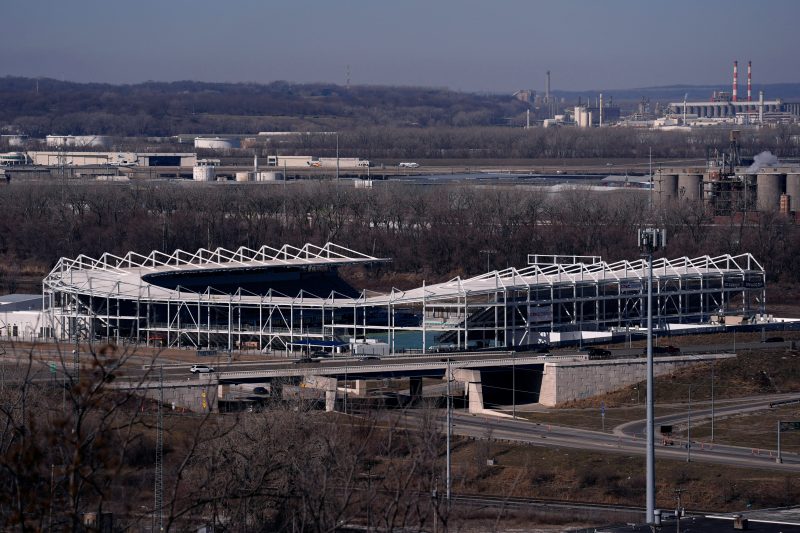If state and local officials are going to hand out money for sports construction projects, it’s high time women’s teams had a place in that line.
At the front of it, preferably.
Men’s teams have been getting public subsidies for decades, so much so some are now on their second and third go-rounds. Women’s teams, meanwhile, haven’t even been part of the conversation. This despite the NWSL kicking off its 12th season Saturday and the WNBA deep into its third decade.
“The reality is, we are doing this and only doing this for men. Men get these giant facilities built for them … and it gives men these huge advantages,” said David Berri, a professor of economics at Southern Utah University and co-author of the upcoming “Slaying the Trolls: Why the Trolls are Very, Very Wrong About Women and Sports.”
“If we’re going to be doing this for men, we should be doing it for women.”
Set aside the question of whether multi-millionaires and billionaires deserve to have the public build their sports palaces for them. Despite all the studies showing these projects don’t generate nearly the jobs or economic boon owners claim they will, politicians long ago decided arenas and stadiums are a fine use of taxpayer dollars and that’s not likely to change.
So if public money is going to be doled out, it is only right women’s teams get a fair share of it, too.
“We are just asking for the same opportunity to have this investment and grow the game,” said Karen Leetzow, president of the Chicago Red Stars. “There’s a lot of opportunity for us to bring attention to the city of Chicago, but it can’t be done without a facility that provides the women a quality playing environment.”
This isn’t some random thought exercise by Leetzow and Red Stars owner Laura Ricketts.
When Rickets bought the team last fall, she acknowledged a new home was needed for the team after its lease in suburban Bridgeview expires in 2025. SeatGeek Stadium is, to put it nicely, geographically undesirable. It’s a torturous drive from both the city and north and western suburbs even when there’s not traffic, and it’s not easily accessible via public transportation.
The Red Stars also don’t control their own schedule or rake in the ancillary revenues because they don’t own the building.
As Rickets and Leetzow were exploring options, the Bears and White Sox were both lobbying state and local officials for public money to build new stadiums. This despite taxpayers not being done paying for their current ones!
“I was like, `Hold on. Wait a minute.’ To me, it’s a fundamental tenet of what we’re facing in women’s sports, a lack of investment,” Leetzow said. “It just seemed obvious that if there was going to be public funding for men’s teams, we ought to have a seat at the table because we are already 100 years behind.”
You can make the argument women actually need it more than men’s teams, given the WNBA and NWSL have spent their entire existences playing on someone else’s turf. When the Kansas City Current opens CPKC Stadium on Saturday, it will be the first stadium ever built specifically for a women’s professional team.
That’s right. Ever.
Those who live to knock down women’s sports will say men’s teams deserve public funding because they make money. But owning their own stadiums and arenas is a large reason why they do. If a team owns or controls its building, it gets the money from naming rights and other sponsors. Parking. Concessions. Merchandise. It can let others use the building — like, say, for a Taylor Swift show — and collect the revenue from those events, as well.
Do you really think the NFL, NBA and Major League Baseball would be where they are now without these cash cows their teams call home? If stadiums and arenas aren’t a significant source of the revenue for men’s teams, then why are they all so eager for shiny new digs or to spruce up the ones they currently have?
“You could almost look at it as men’s teams got their seed funding from public sources. It’s allowed for them to have all those things: control over revenue streams, control over their schedule, (flexibility) with broadcasters. None of that has ever been available to women’s teams,” NWSL commissioner Jessica Berman said.
“Then we say, `Oh it’s 2024 and let’s compare.’ It hasn’t been a level playing field.”
Now, some men’s team owners have built their own Taj Mahals. Los Angeles Rams owner Stan Kroenke splashed out $5 billion on SoFi Stadium. Steve Ballmer built the Los Angeles Clippers a $2 billion arena.
Kansas City Current owners Angie and Chris Long went that route, financing all but about $6 million of the team’s new $117 million stadium themselves. The public money, in the form of tax credits for infrastructure improvements, became necessary when the cost of the project ballooned.
The Longs and co-owners Brittany and Patrick Mahomes also shelled out their own cash on the Current’s $18 million practice facility, which opened in June 2022.
But that shouldn’t be the expectation. Because it’s never been for men’s teams.
“I hope that equity isn’t something that causes a backlash,” Leetzow said. “I hope it’s the opposite, that there’s a recognition that we’ve never asked for this before. And if you’re going to give anyone money, it ought to be those that haven’t had the opportunity (for it) previously.”
Cities and states have long seen men’s teams as worthwhile public investments. There’s no reason they should see women’s teams any differently.
Follow USA TODAY Sports columnist Nancy Armour on social media @nrarmour.

